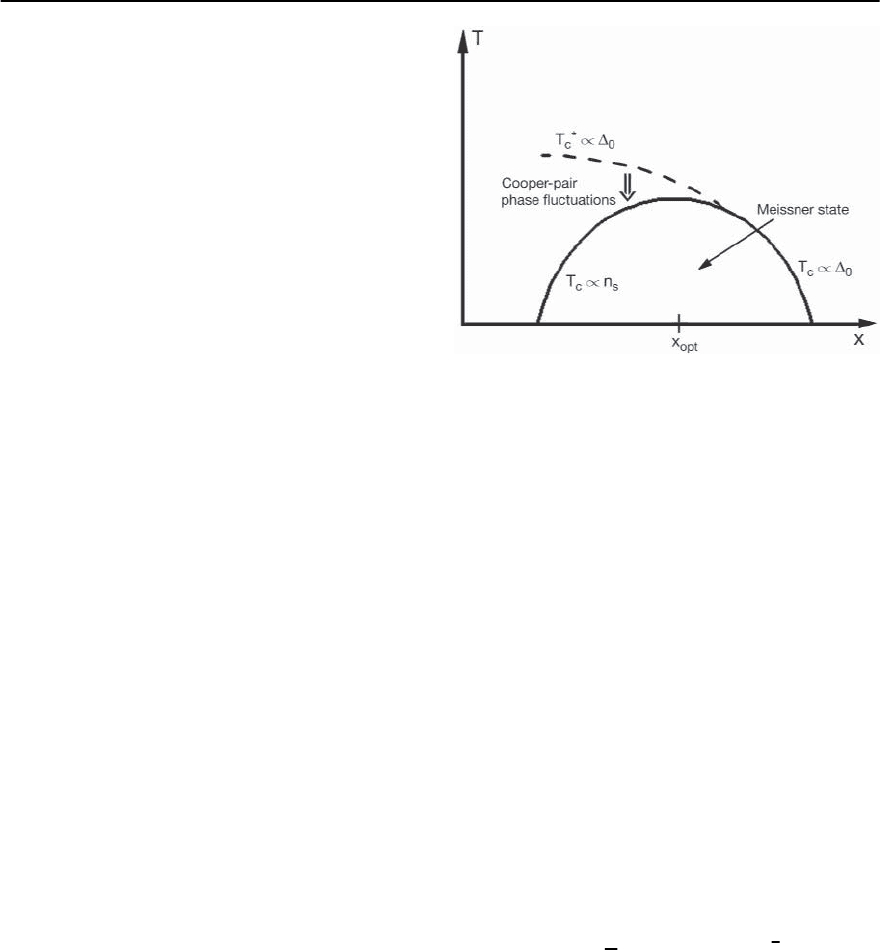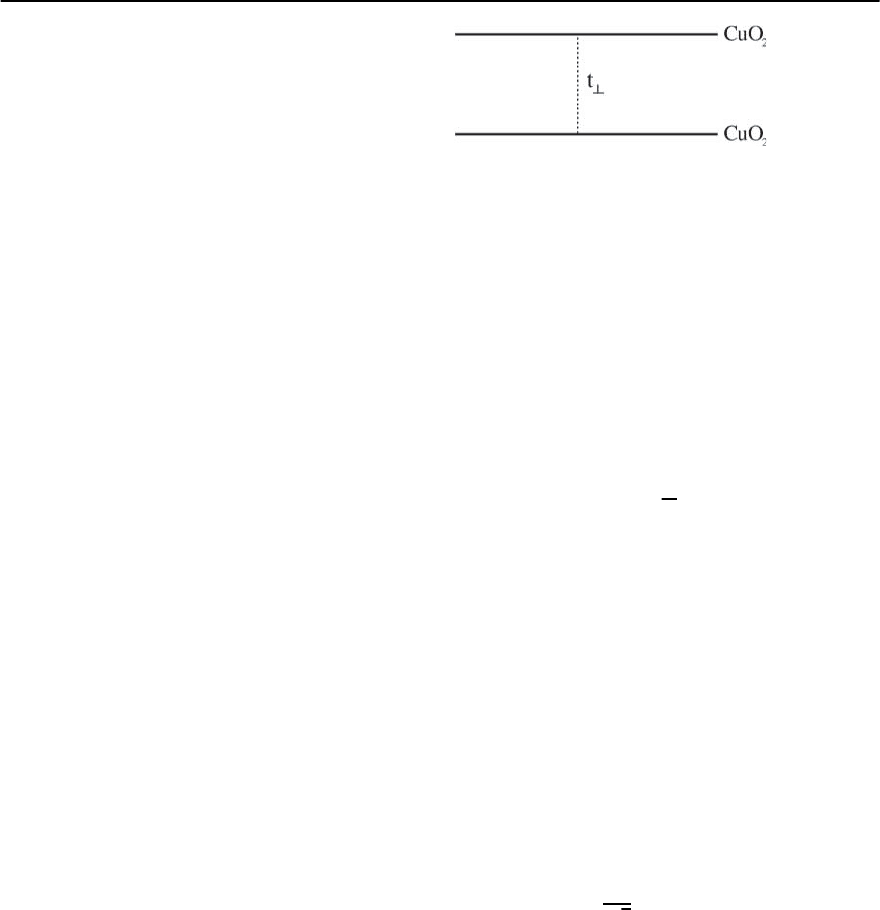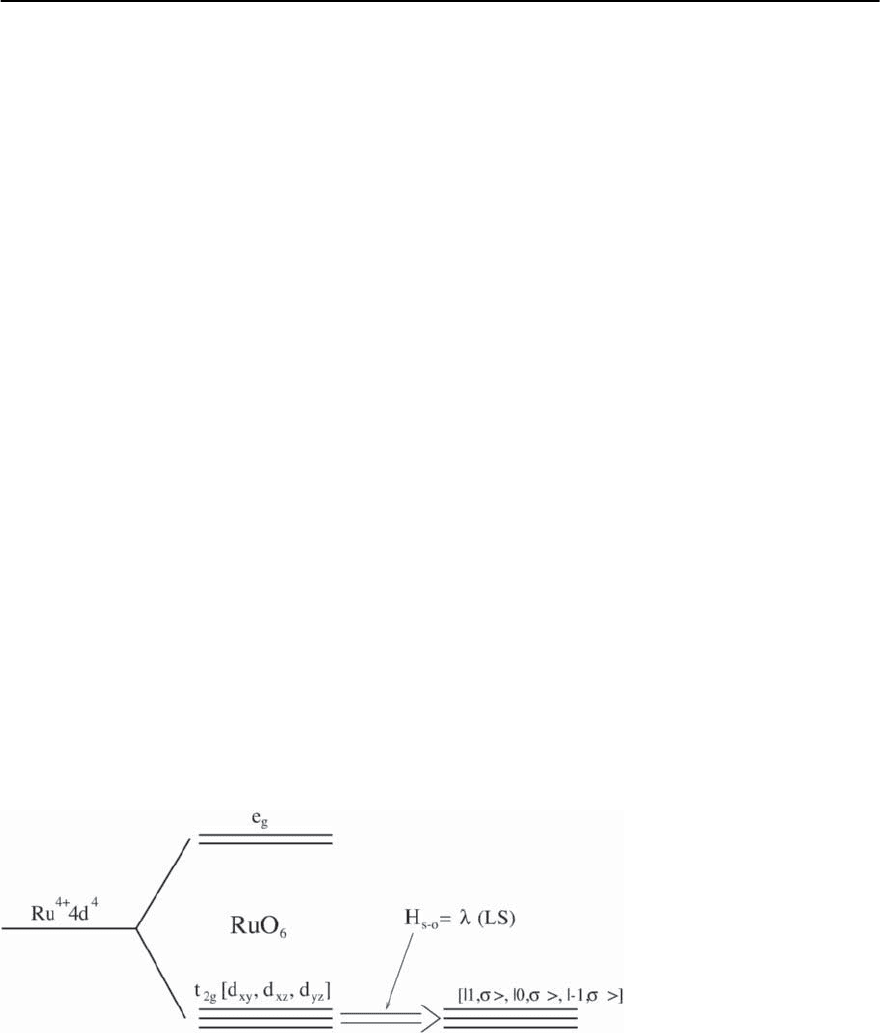Bennemann K.H., Ketterson J.B. Superconductivity: Volume 1: Conventional and Unconventional Superconductors; Volume 2: Novel Superconductors
Подождите немного. Документ загружается.


1442 D. Manske,I. Eremin, and K.H.Bennemann
where we have introduced for convenience the oscil-
lator strength
S
N
=
2
c
2e
2
t
∞
0
+
1
(!)d! . (23.52)
S
S
is the corresponding value of (23.52) in the super-
conducting state. In (23.52) we have used the f -sum
rule for the real part of the conductivity
1
(!)
∞
0
1
(!)d! = e
2
n/2m
∗
,
where n is the 3D hole density and m
∗
denotes the ef-
fective band mass (in our case for the tight-binding
band considered). The conductivity (!)thaten-
ters the equations above is calculated in the nor-
mal and superconducting state using the Kubo for-
mula [73,80]
(
!
)
=
2e
2
c
!
∞
−∞
d!
f (!
)−f (!
+ !)
×
1
N
k
v
2
k,x
+ v
2
k,y
(23.53)
×
N(k, !
+ !) N(k, !
)A
1
(k, !
+ !) A
1
(k, !
)
.
Here,v
k,i
= ∂
k
/∂k
i
arethe calculatedbandvelocities
within the CuO
2
-plane and c is the c-axis lattice con-
stant.The spectral functionsN and A
1
are defined in
(23.168).Vertex correctionshave been neglected.
Physically speaking, we are looking for the loss
of spectral weight of the Drude peak at ! =0that
corresponds to excited quasiparticles above the su-
perconducting condensate for temperatures T < T
∗
c
.
Then, with the help of above equations we calculate
the dynamical conductivity (!)via(e =elemen-
tary charge) [73]
n
s
(!)
m
=
1
e
2
! Im (!) , (23.54)
where Im (!) has been obtained using (23.54)
from the current–current correlation function and
the Kubo formula. In a next step the penetration
depth (x, T) is calculated within the London the-
ory [81] by
−2
∝ n
s
This will be discussed later.
Of course, in particular for underdoped cuprates
phase fluctuations of the Cooper-pairs must be in-
cluded into the calculation of n
s
. A generalization of
(23.54) leads to
n
s
(q, !)=! Im (q, !) . (23.55)
(Note that the derivation requires Fermi-liquid-like
argumentsassuming a thermodynamical phase tran-
sition which might not be valid if the limit T → 0
in the vicinity of a quantum critical point (QCP) is
considered. This will be discussed in Sect. 23.4.7.)
Since the conductivity can be expressed in terms
of a current–current correlation function, n
s
is re-
lated to J(r, t)·J(0, 0),whereJ ∝
∗
∇ − ∇
∗
.
Using (r, t)=| |e
i(r,t)
one arrives at (∇(0, 0) =
2e
c
−→
A (0, 0) for frozen amplitude fluctuations,see Ap-
pendix D.)
n
s
∼∇(r, t) ·∇(0, 0). (23.56)
On general grounds one expects that the phase cor-
relation function C = ∇ ·∇
behaves as C → 1
for large doping x and that a Meissner effect occurs
only for C(T) → 1atT
c
.
12
(Here, ∇ ·∇
means
phase averaging).
From this we can calculate n
s
(q, !) and its doping
dependence. For overdoped cuprates and for T → 0
we expect that phase fluctuations play a minor role,
the see detailed discussion in the next section, while
for underdoped cuprates (x → 0) Cooper-pair phase
fluctuations should become more and more impor-
tant. However, for frequencies ! ∼ 1/time > !
phase
the behavior of n
s
(q, !)shouldcorrespondtothe
12
In analogy to ferromagnetism like in Ni we expect n
0
s
/n
s
= ∇¥ (r, t)∇¥ (0).Notethatitisstraightforwardtomap
our electronic theory on a lattice (Wannier type representation) and then to derive from the product of the anomalous
Green’s functions, {F · F
∗
}, a contribution to the free energy of the form n
s
cos Ÿ
ij
as used by Chakraverty et al. [78].
Here, Ÿ
ij
is the angle between the phase of neighboring Cooper-pairs. Approximately, one has n
s
= n
0
s
¯
Ÿ
ij
,with
¯
Ÿ
ij
=1
for T < T
c
and
¯
Ÿ
ij
=0forT > T
c
.

23 Electronic Theory for Superconductivity 1443
case where no phase fluctuations are seen. In this
connection !
−1
phase
=
1
refers to the lifetime of the
phase fluctuations. In underdoped cuprates it de-
scribes the dynamics of n
s
.Weestimatethelifetime
from
1
∝
−1
∝ T
−1
c
, since the energy change
involved in the excitations is of the order of e
i
.
Note that above T
c
one has e
i
= 0 due to phase-
incoherent Cooper-pairs.
In summary, our mean field results for n
s
(x, T)
areexpectedtobeapproximatelyvalidforoverdoped
cuprates and also for underdoped cuprates if T → 0
for times shorter than the lifetime of the phase fluc-
tuations. If Cooper-pair phase fluctuations become
important the superfluid density is given by (23.56).
Note that for q → 0,! → 0 after phase averaging of
∇(r, t)·∇(0, 0)→0 onearrivesat T = T
c
.Thus,
the Meissner effect occurs only for phase-coherent
Cooper-pairs.In the following we safely approximate
the phase correlation function ∇ ·∇≈0above
T
c
.BelowT
c
one takes ∇∇≈1 for simplicity.
This is approximately true for Gaussian fluctuations.
23.2.7 Cooper-Pair P h ase Fluctuations
As mentioned above the cuprates consist of weakly
coupled two-dimensional CuO
2
planes. For doping
x → 0 the Cooper-pairs do not overlap much.There-
fore, one expects that Cooper-pair phase fluctuations
are enhanced. These fluctuations of phase incoher-
ent Cooper-pairs destroy the long-range supercon-
ducting order and the Meissner effect. In conven-
tional bulk superconductors Cooper-pair phase fluc-
tuations are not relevant, since the large superfluid
density leads to a strong overlap of Cooper-pairs and
the phase fluctuations cost much energy. Thus, in
conventional superconductors the superconducting
transition is due to the destruction of the Cooper-
pairs and T
c
is proportional to
0
[76]. On the other
hand,the observationbyUemura et al.that T
c
∝ n
s
in
underdoped hole-doped cuprates [14] indicates that
the phase fluctuations drive the transition in these
regime. Then, at T → T
c
where F
phase
T
c
phase
coherent Cooper-pairs occur. F
phase
denotes the
free energy contribution due to phase fluctuations.
Cooper-pairs might exist above T
c
and break only up
at a crossover temperature around T
∗
c
> T
c
. Here, T
∗
c
Fig. 23.23. Illustration of the significance of Cooper-pair
phase fluctuations in underdoped cuprates with low super-
fluid density n
s
.With the help of the generalized Eliashberg
theory below the crossover temperature T
∗
c
one finds local
Cooper-pairs without long-range phase coherence (“pre-
formed pairs”). The temperature T
c
denotes the supercon-
ducting phase transition temperature below which phase
coherent Cooper-pairs and the Meissner effect occur. For
x < x
opt
one gets T
∗
c
→ T
c
due to phase fluctuations
is approximately given by the transition temperature
that one would obtain without phase fluctuations.
Note that the Meissner effect takes place only below
T
c
. This situation is illustrated in Fig. 23.23.
The bulk transition temperature T
c
at which
phase coherence of the Cooper-pairs occurs is de-
termined by the Ginzburg–Landau free energy func-
tional F{n
s
, } where the superfluid density di-
vided by the effective mass m, n
s
(x, T)/m,iscal-
culated self-consistently from the current–current
correlation function. First, we consider the static
case, i.e. n
s
= n
s
(!). The doping dependence of
the Ginzburg–Landau-like free-energy change (see
n
s
(x, T)) is given by
F = F
S
− F
N
=−
1
ˇ
ln
D
†
D e
−
1
S
eff
[
†
,]
.
(23.57)
The functional integral is taken over the fields D
†
=
D
r
i
,t
i
d
†
(r
i
, t
i
). The effective action S
eff
is defined
in Appendix D where we also derive the Dyson equa-
tion for the Cooper-pair phase fluctuations on a mi-
croscopic level. On phenomenological grounds the

1444 D. Manske,I. Eremin, and K.H.Bennemann
Gor’kov equations including the phase fluctuations
were derived by Berthod and Giovannini [82]. Equa-
tion (23.57) is the basis for determining T
c
in the
presence of Cooper-pair phase fluctuations. For sim-
plicity, we neglect first the interaction between the
amplitude and the phase of Cooper-pairs (see foot-
note on page 1442 and Appendix D for details of
the interplay between amplitude and phase fluctua-
tions).Then, we write
F = F
cond
+ F
phase
, (23.58)
where F
cond
≈ ˛{n
s
/m
∗
}
0
(x) is the condensation
energy due to Cooper-pairing and F
phase
≈
2
n
s
2m
∗
is
the loss in energy due to phase incoherent Cooper-
pairs. Here, ˛ denotes the available phase space for
Cooper-pairs normalized per unit volume and can
be estimated in strongly overdoped regime. In con-
trast to conventional superconductors in cuprates
˛ is smaller mainly due to large size of the unit
cell [83–85]. This will be discussed later in connec-
tion with Fig. 23.52.
From the interplay between condensation energy
and phase fluctuation energy we can estimatethe role
of phase fluctuations for determining T
c
at different
doping. One expects that for underdoped cuprates
0.15 > x → 0, phase fluctuations get more impor-
tant and cost less energy. Thus F
phase
< F
cond
and
consequently T
c
∼ F
phase
< F
cond
∼ T
∗
c
.Note
that Cooper-pairs break up thermally at T
∗
c
. Since
F
phase
∝ n
s
one gets due to Cooper-pair phase fluc-
tuations T
c
(x) ∝ n
s
(x) in the underdoped regime.
In the overdoped case the situation is described by
the fact that Cooper-pair phase fluctuations cost too
much energy. Consequently, the system undergoes a
mean-field transition according to a gain in conden-
sation energy F
cond
and then T
c
(x) ∝
0
(x). Note
that the explicit derivation of the free-energy func-
tional is given in Appendix D. The Meissner effect
only occurs if after phase averaging n
s
(! → 0) =0
yielding a London penetration depth
1
2
(T)
∝ n
s
(T, ! =0).
Here, n
s
refers to the phase averaged superfluid den-
sity. Within standard (time-dependent) Ginzburg–
Landau theory (see footnote on page 1442), the su-
perfluid density n
s
can be calculated through (23.56).
To summarize, using this physical picture one al-
ready obtains on general grounds a superconducting
phase diagram and in particular an optimum T
c
and
doping concentration as it is illustrated in Fig. 23.23.
In particular, calculating F
cond
and F
phase
from
the generalized Eliashberg equations one finds an
optimal doping concentration at x
opt
0.15. We
get T
c
∝ F
cond
∼
0
for overdoped cuprates and
T
c
∝ F
phase
∼ n
s
for underdoped cuprates. Clearly,
the Meissner effect occurs only for phase coherent
Cooper-pairing and
−2
∝ n
s
.
BKT Theory for Cooper-Pair Phase Fluctuations
Due to the layered structure of the cuprates and
weak interlayer coupling the underdoped cuprates
should behave in accordance with the 2D-XY model
(except in a narrow critical range around T
c
where
3D-XY is more appropriate) [86,87].Thus, the stan-
dard theory for the 2D-XY model, the Berezinskii–
Kosterlitz–Thouless (BKT) renormalization group
theory, should be a reasonable starting point for a
study of Cooper-pair phase fluctuations [88–91]. In
particular we discuss the determination of T
c
with
the help of the BKT theory similar to the work by
Timm et al. [92].
The superconductingtransition predicted by BKT
theory is due to unbinding of fluctuating vortex–
antivortex pairs in the superconducting order pa-
rameter. Gaussian phase fluctuations are not im-
portant, since they do not shift T
c
. (This is true in
three dimensions. Of course, in the 2D case Gaus-
sian fluctuations destroy the long-range order yield-
ing T
c
= 0, but the mean-field transition is still un-
changed.) Since we are mainly interested in the de-
termination of T
c
, we first consider the static case
where the phase does not depend on frequency.
Then, the phase action is given by
S
phase
=
˜
K
2
d
2
r (∇)
2
, (23.59)
where the phase stiffness is related to the super-
fluid density through
˜
K = n
s
(T)
2
/(4m
∗
T). For

23 Electronic Theory for Superconductivity 1445
the cuprates it turns out that the relevant parame-
ters for the unbinding of thermally created vortex–
antivortex pairs are the dimensionless stiffness K
and the vortex core energy E
core
. The vortex core en-
ergy refers to the energy amount that is needed for
the suppression of the superconducting order pa-
rameter in the vortex core, i.e. (r → r
core
)=0.
This, in general will renormalize the phase stiffness
yielding K → K
r
. The stiffness is related to n
s
by
K(T)=ˇ
2
n
s
(T)
m
∗
d
4
, (23.60)
where ˇ denotes again the inverse temperature and
m is again the effective mass.d is the average spacing
between CuO
2
layers. In our calculations we set d to
half the height of the unit cell of YBa
2
Cu
3
O
6+x
, see,
forexample [92].Notethatthe renormalizedstiffness
K
r
is related to the superfluid velocity through
1
K
r
=
4m
2
2
d
2
r v
s
(r) · v
s
(0). (23.61)
For determining T
c
one has to solve the Kosterlitz
recursion relations (“flow equations”) [88,92]
dy
dl
=
(
2−K
)
y (23.62)
and
dK
dl
=−4
3
y
2
K
2
. (23.63)
Here, y = e
−ˇE
c
denotes the vortex fugacity. For the
vortex core energy we use the approximate result by
Blatter et al., i.e. [87]
E
core
= k
B
TK ln , (23.64)
where is the Ginzburg parameter.l =(r/r
0
)isalog-
arithmic length scale which relates K to the strength
of the vortex–antivortex interaction. Note that for
T > T
c
, K tends to zero for l →∞. The interaction
at large distances is screened and the largest vortex–
antivortex pair unbind. This destroys the Meissner
effect and leads to dissipation. On the other hand,
bound Cooper-pairs reduce K and thus n
s
,butdo
not destroy superconductivity.After solving (23.62)-
(23.64) it turns out that the renormalization of K
is very small [92]. Thus, within a good approxima-
tion,Timm et al. obtain T
c
(x)fromthesimplecrite-
rion [88,92–94]
13
K(T
c
)=
2
, (23.65)
or
n
s
(T
c
, x)
m
∗
=
2
4k
B
T
c
2
d
. (23.66)
The superfluid density n
s
(T, x) entering (23.66) is
calculated from the generalized Eliashberg equations
using (23.56)–(23.54).
Finally, in order to compare our results also
with time-dependent measurements we calculate
n
s
(!, T). Regarding the frequency dependence of n
s
we mention the following: A dynamical generaliza-
tion of the BKT theory has been developed by Am-
begaokar et al. [90,95]. It turns out that the critical
size for a vortex–antivortex pair is given by
r
!
=
7
D
2!
, (23.67)
where D
denotes the corresponding diffusion con-
stant. Only pairs with size r ≤ r
!
contribute to the
screening. Unfortunately, D
is not easy to calculate.
In the absence of pinning,the theory by Bardeen and
Stephen yields [96]
D
0
=
2c
2
2
ab
n
T
2
0
˜
d
, (23.68)
where c is the speed of light,
ab
∼ r
0
/2corresponds
to the coherence length,
n
denotes the normal-state
resistivity,
0
= hc/2e is the elementary supercon-
ducting flux quantum, and
˜
d corresponds to an ef-
fective layer thickness. However, in cuprate super-
conductors, pinning becomes important. Thus, we
assume a simple Arrhenius law
D
= D
0
exp
−E
p
T
, (23.69)
13
In FLEX theory the fluctuations of the ordered antiferromagnetic state in the paramagnetic metallic regime are treated
beyond the mean-field level. However, the fluctuations of the superconducting condensate were neglected in earlier
treatments.A detailed comparison between n
s
(!) within the XY model and the FLEX approximation is given in [92,94].

1446 D. Manske,I. Eremin, and K.H.Bennemann
where E
p
denotes the corresponding pinning energy
barrier. Equations (23.69) and (23.68) are inserted
into (23.67) yielding a new length scale l in (23.62)
and (23.63),namely a new upper limit l =ln(r
!
/r
0
).
Thus, we get n
s
(!, T)/m
∗
= ! Im (!)/e
2
where
the conductivity (!) is obtained from the current–
current correlation function. Since 1/! ∼ time,and
we refer to the time of an observation, we expect
phase coherence already for ! 1, where refers
to the lifetime of phase fluctuations.
Resum´e
In summary, we have demonstrated on general
grounds that the interplay between Cooper-pair con-
densation energy and phase fluctuation energy al-
ready yields an optimal doping concentration. Thus,
the phase diagram can be described in the overdoped
part by T
c
∝
0
and in the underdoped case by T
c
∝
n
s
. The superconducting transition temperature T
c
in underdoped cuprates might be estimated by the
BKT theory.It is interestingthat n
s
=(m/e
2
)!
(!)
gives n
s
∝
DC
T
c
if (!
/
DC
T
c
)
!=0
=const.Such
a scaling was noted by C. Homes et al. [97]. For un-
derdoped cuprates one observes (
DC
T
c
)
T→T
c
to be
independent of T.
The dynamical stiffness ∝ n
s
(!)providesinfor-
mation about the time-scale of Cooper-pair phase
fluctuations. In our theory these are treated classi-
cally and the coupling between amplitude and phase
has been neglected.The results for n
s
(!)canbecom-
pared with time-resolved measurements. Note that
for ! > !
phase
,where!
phase
refer to the phase fluc-
tuations, one expects a behavior as in the absence
of the phase fluctuations. Thus n
s
(!) → n
s
(T, x)in
the absence of the Copper-pair phase fluctuations.
We further would like to mention that phase fluctu-
ations are also related to the formation of vortices.
For details see Appendix D.
23.2.8 Tunneling Spectra
A most important verification of the approxi-
mate validity of the conventional Eliashberg the-
ory came from electron tunneling experiments.
They probe the k-averaged quasiparticle excita-
tion spectra in the normal and superconducting
state. Therefore, in the case of singlet pairing in
high-T
c
cuprates and triplet pairing in ruthenates
also important fingerprints of the spin-fluctuation-
mediated pairing interaction can be seen. Hence, we
nowanalyze tunneling in superconductor–insulator–
normal metal (SIN) and superconductor–insulator–
superconductor (SIS) junctions.
Using standard tunneling theory [98] we have
H = H
L
+ H
R
+ H
T
, (23.70)
where H
L
(H
R
) is the Hamiltonian for particles on the
left-hand side (right-hand side) of the tunnel junc-
tion. Note, H contains all many-body effects. Here,
in general, [H
L
, H
R
]=0.H
T
denotes the tunnel op-
erator with a matrix element T
pk
. The total current
through the tunnel junction can be expressed as the
average rate of change per time t of the number of
particles. For example, on the left-hand-side of the
junction ( =1),
I
tot
(t)=−e
˙
N
L
(t) (23.71)
=−ei
t
−∞
dt
[N
L
(t), H
T
(t
)] .
Aftersomealgebra[73]onearrivesat
I
tot
(t)=I
s
(t)+I
J
(t) ,
where
I
s
(t)=e
∞
−∞
dt
(t − t
) (23.72)
×
e
ieV(t
−t)
[A(t), A
+
(t
)]
−e
ieV(t−t
)
[A
+
(t), A(t
)]
,
and
I
J
(t)=e
∞
−∞
dt
(t − t
) (23.73)
×
e
−ieV(t
+t)
[A(t), A(t
)]
−e
ieV(t+t
)
[A
+
(t), A
+
(t
)]
.
Here, I
s
refers to the single-particle tunneling and
I
J
describes tunneling of Cooper-pairs, the Joseph-
son effect. The operator A is given by A(t)=

23 Electronic Theory for Superconductivity 1447
k,p
T
kp
c
+
k
(t)c
p
(t)wherec
+
k
(c
p
) refers to the single-
particle creation(annihilation)operator entering the
Hubbard Hamiltonian, and eV is the applied voltage.
In order to study the single-particle excitations
we focus in the following on I
s
. A closer inspection
of (23.73) shows that the current can be expressed as
I ∝ (G
red
− G
adv
)whereG
red
(G
adv
) is the retarded
(advanced) Green’s function that correspond to the
operator A. This would lead to I
s
=−2e Im (G
red
)
and is important for SIS junctions. In the case of SIN
tunneling one obtains [73,76]
I
s
=2e
k,p
|T
k,p
|
2
∞
−∞
d!
2
A
R
(k, !) (23.74)
× A
L
(p, ! +eV)
f (!)−f (! +eV)
,
where f (!) again denotes the Fermi distribution
function and A
L
and A
R
is the spectral density of
the left-hand-side (sc-state) and right-hand-side (n-
state) material, respectively. The factor 2 arises from
the spin summation.The matrix element T
k,p
(i.e.the
transfer rate) varies on the energy scale E/E
F
which
should be negligible if E
0
. Thus, an adequate
approximation should be to take T
k,p
= T
0
=const.
Note the elementary excitations are entering in
(23.75) via A(k, !). In particular, the frequency de-
pendence of the gap, (!), reflecting the dynamics
of the Cooper-pairing is of importance. Performing
the sum over momenta we obtain the important re-
sult that the single-particle density of states N(!)is
proportional to the dynamical conductivity dI
s
/dV
(normalized by its normal-state value) for a SIN tun-
neling junction system measured at ! =eVwithV
being the applied voltage:
tun
(eV) =
dI
s
(eV)
dV
∝
k
A(k, !)=N(!) . (23.75)
Obviously,below T
c
the tunneling density of states
tun
(eV) in cuprates reveals interesting structures
due to the interaction of quasiparticles with antifer-
romagnetic spin fluctuations and the opening of the
superconducting gap.What is the energy position of
these structures? In the superconducting state the
spin fluctuation spectrum is peaked at the resonance
energy !
res
. Thus, the structure in the NIS tunneling
occurs at
!
res
+
0
(NIS) . (23.76)
This follows immediately from (23.75), since the
spectral density A(k, !) in the superconductor re-
flects !
res
and the shift of the quasiparticle density
by
0
.
In the case of SIS tunneling the characteristic fea-
tureinthe tunnelingspectrumis shiftedto the higher
energy
!
res
+2
0
(SIS) . (23.77)
Again, in addition to !
res
each spectral density shifts
the energy by
0
.
The maximum gap value
0
and the resonance
frequency !
res
are both doping dependent quanti-
ties. As mentioned earlier to a good approximation
one finds !
res
(x) ∝ 2
0
(x)andT
c
T
∗
c
∝
0
in the
overdoped case and !
res
(x) ∝ !
sf
(x)intheunder-
dopedcuprates.Thus,in overdoped cupratesa reduc-
tion of spectral weight (“dip”) is expected at around
!
res
+
0
3
0
(SIN),and in underdoped cupratesat
!
res
+
0
!
sf
+
0
(SIN).Similarly we get for over-
doped cuprates structure at !
res
+2
0
4
0
(SIS),
and for underdoped ones at !
res
+2
0
!
sf
+2
0
(SIS). We will see later in Sect. 23.4.8 that this agrees
well with available experimental data [20,99]. There-
fore, we may safely conclude that as in the BCS and
conventional Eliashberg theory the single-particle
tunneling spectrum reflects the density of states and
thus provides insight into the strength and dynamics
of the Cooper-pairing.
Finally,we wouldlike to mentionthat for electron–
phonon mediated superconductivity the spectrum
of the pairing potential is mainly unchanged in the
superconducting state with respect to the normal
state. Thus, structure in the tunneling spectrum is
expected at an energy !
D
where !
D
is the Debye
frequency. In contrast to this, in the case of spin-
fluctuation-mediated Cooper-pairing strong feed-
back effects are present yielding anisotropic elemen-
tary excitations and a renormalized spin spectrum
(!
sf
→ !
res
). This leads to the structure described
above and is clearly a direct fingerprint of Cooper-
pairing by spin fluctuations and is expected for both
hole-dope and electron-doped cuprates. In addition,

1448 D. Manske,I. Eremin, and K.H.Bennemann
also the momentum dependence of the supercon-
ducting order parameter is reflected in the tunneling
spectrum. In particular, for an order parameter with
s-wave symmetry resulting from electron–phonon
interaction, one finds an isotropic density of states
with a gap for frequencies |!| < 2
0
.Incontrast,in
the case of unconventional superconductivity where
the order parameter has nodes, thermal excitations
with energies smaller than 2
0
arepossible(around
the nodes). Using thermodynamic arguments one
can easily show that the density of states has a linear
slope for ! → 0 [27]. Note that additional structure
might occur due to Andreev bound-states in SIN
and SIS tunneling, whichcannot be described by our
theory.
Note, the spectral density A(k, !) exhibits par-
ticle-hole asymmetry reflecting the correlations
amongst the quasiparticles. (see an early discussion
of this by Sawatzky et al.[100] and Bennemann et al.,
and others.)
23.2.9 Bilayer Effects
Many high-T
c
cuprates contain more than one CuO
2
-
plane per unit cell like for example YBCO or BISSCO
compounds (see Fig. 23.2). So far,our theory has fo-
cused mainly on the physical properties of a single
CuO
2
-plane. Of course, it is desirable to understand
how the properties change if several CuO
2
-planes per
unit cell are present and how the number of CuO
2
-
layers per unit cell affects T
c
(x), for example. Note
that the bilayer coupling t
⊥
causes changes of the
Fermi surface topology and the dispersion
k
.There
is also an interlayer coupling of Cooper-pairs. For
several CuO
2
-planes per unit cell also effects due
to varying hole doping are expected. The simplest
situation is illustrated in Fig. 23.24 where we show
schematically the coupling of two CuO
2
-planes via
the coupling parameter t
⊥
.
In the following we will present an extension of
the generalized Eliashberg-like theory for the case of
two coupled CuO
2
-planes [101,102]. We start from a
Hamiltonian that contains nearest and next nearest
neighbor hopping t and tt
, respectively, as well as
an intra-layer Coulomb repulsion U, an inter-layer
interactionV and an inter-layer hopping t
⊥
.Thecor-
Fig. 23.24. Illustration of the interlayer coupling t
⊥
affect-
ing the energy dispersion
k
, Fermi surface and Cooper-
pairing across CuO
2
-layers. The magnetic coupling be-
tween the planes, J
⊥
, is not displayed. It is one order of
magnitude smaller than the in-plane (Heisenberg-like) su-
perexchange J
and thus is not considered in our electronic
theory.However,I
⊥
will split the spin-susceptibility into an
even and odd part, see neutron scattering experiments
responding Hamiltonian is given by
H = H
int
+ H
hop
, (23.78)
and with U
eff
= U
H
int
= U
i
n
il↑
n
il↓
+
V
2
i=j
l
n
il
n
jl
, (23.79)
and
H
hop
=−
i,jl
t
l
c
†
il
c
jl
− t
⊥
i
c
†
i1
c
i2
. (23.80)
Here, c
†
il
(c
il
) creates (annihilates) an electron on
site i in the layer l =1orl =2withspin and
n
il
= c
†
il
c
il
. We diagonalize the Hamiltonian with
respect to the hopping term. Thus, we perform a
transformation in term of the operators d
k
with
the help of
c
kl
=
S
l
d
k
,
S
l
=
1
√
2
e
−ik
z
c
e
−ik
z
c
e
−ik
z
c
−e
−ik
z
c
, (23.81)
where =+and = − denotes the bonding and
antibonding band,respectively, 2c is the distance be-
tween adjacent planes, and k is the in-plane momen-
tum. Thus, (23.80) can be rewritten as
H
hop
=
k
(d
k1
, d
k2
)
+
(k)0
0
−
(k)
d
k1
d
k2
,
(23.82)

23 Electronic Theory for Superconductivity 1449
with
±
=−2t
cos(k
x
)+cos(k
y
)
−2t
cos(k
x
)cos(k
y
)+
2
∓ t
⊥
. (23.83)
One is now able to extend the generalized Eliash-
berg equations as described at the beginning of this
chapter. The corresponding Bethe–Salpeter equa-
tions separate with respect to band indices into two
sets of coupled equations [101,103]. If, forsimplicity
the inter-plane Coulomb repulsion V is neglected we
find six coupled equations for the self-energy com-
ponents:
£
i
(k, !)=N
−1
k
=+,−
∞
0
d§
P
s
(k − k
, §)
+(ı
0
+ ı
3
− ı
1
) P
c
(k − k
, §)
×
∞
−∞
d!
I(!, §, !
)A
i
(k
, !
) , (23.84)
(for a comparison, see (23.23)). In a shorthand nota-
tion we get
£
ll
(k)=
k
V
ll
(k − k
) G
ll
(k
) , (23.85)
where V
ll
is the effective pairing interaction due to
spin (and also charge) fluctuations.
Obviously, V and thus the dynamical spin suscep-
tibilities
s,c
are 2 × 2 matrices in the layer indices,
having elements diagonal (
aa
,
bb
) and off-diagonal
(
ab
,
ba
) with respect to the layer indices. The com-
ponents of the spin susceptibility transforming as
even and odd with respect to the layer indices are
given by
e
=
aa
+
bb
and
o
=
ab
+
ba
.Foriden-
tical planes
aa
=
bb
and
ab
=
ba
.Themeasured
susceptibility is then given
(q, q
z
, !)=
e
(q, !)cos
2
q
z
c
2
+
o
(q, !)sin
2
q
z
c
2
, (23.86)
where c is the separation of the layers within a unit
cell,q isthein-planewavevector,andq
z
denotes the
component perpendicular to the planes. Note, if in
cuprates or ruthenates the spin response in INS ex-
periments would dominate at the wave vector q
z
= ,
for example, one would expect that
o
e
in
(23.86).
23.2.10 Electron-Doped Cuprates
Although we discussed in the previous chapters al-
ready the differences and similarities of electron-
doped and hole-doped cuprates (in particular the
evolution of antiferromagnetism as a function of the
doping concentration) it is of interest to summarize
the significantproperties of the electron-doped com-
pounds. The understanding of the phase diagram of
the electron-doped cuprates should play a role in re-
solving the physics of cuprates in general.
In Fig. 23.25 we show the phase diagram for the
metallic phase of electron-doped cuprates. The be-
havior of T
c
upon doping follows a parabolic-like
curve with a narrow doping range for which super-
conductivity occurs.Therefore,despite the rather dif-
ferentbehavior ofthe spin fluctuationsinhole-doped
(localized) and electron-doped (itinerant) cuprates
the doping dependence of the T
c
curve looks simi-
lar in hole-doped and electron-doped cuprates. This
suggests the same mechanism for Cooper-pairing
and, most importantly, indicates the similar role
played by the localized and itinerant spin fluctua-
tions. The appearance of the“pseudogap”in the elec-
tronic spectrum of electron-doped cuprates has been
debated for a long time.Recently its existence in the
presence of a high magnetic field has been confirmed
by careful tunneling spectroscopy by Alff et al. [77].
In particular, it has been found that the pseudogap
shows a very similar doping dependence as in hole-
doped cuprates, but its temperature range is lower.
Moreover, as seen from Fig. 23.25 as in hole-cuprates
the energy scale of the pseudogap and superconduc-
tivity crosses each other around the optimal doping
and the pseudogap disappears in slightly overdoped
cuprates. This confirms the close similarity between
electron-doped and hole-doped cuprates regarding
most of the properties.It also suggests that the mech-
anism of superconductivity,symmetry of the super-
conducting order parameter,andtheanomalousnor-

1450 D. Manske,I. Eremin, and K.H.Bennemann
Fig. 23.25. Phase diagram of the electron-doped
cuprates measured by tunneling experiments
on thin films (taken from [77]). Note the nar-
row range of superconductivity in electron-
doped cuprates,and the smaller energy scale of
the pseudogap. Both hole-doped and electron-
doped cuprates show a similar phase diagram
indicating the same mechanism for supercon-
ductivity below T
c
and pseudogap below for-
mation T
∗
.The doping concentration where the
pseudogap disappears may be related to a quan-
tum critical point (QCP)
mal state properties should have the same origin in
both compounds.
Inorder todiscussthemaindifferenceinFig.23.26
we show our results for the Fermi surface of the hole-
doped and electron-doped cuprates.These agree well
with available experimental data [104]. Remarkably,
the differences of the Fermi surfaces in the first BZ
in hole and electron-doped cuprates have important
consequences for their superconducting and normal
state properties. In particular, the antiferromagnetic
spin fluctuations which are peaked at Q =(, )
connect different portions of the Fermi surface in
hole-doped and electron-doped cuprates as one can
see in Fig. 23.26. Inthe hole-doped cuprates the anti-
ferromagnetic wave vector connects the carriers that
lie close to the M =(, 0) point of the first BZ. This
means that the main scattering by the spin fluctu-
ations occurs in hole-doped cuprates around these
points (so-called “hot spots”). On the other hand, in
the electron-doped cuprates the antiferromagnetic
wave vector Q =(, ) connects carriers that are
close to the diagonal of the BZ. Therefore, the main
effect of the interaction will occur there. This will be
reflected in the asymmetrical behavior of the hole-
doped and electron-doped cuprates.
What are the consequences for the superconduct-
ing state? In particular, we expect the appearance
of the higher harmonics in the d
x
2
−y
2
-wave super-
conducting order parameter in the electron-doped
Fig. 23.26. Tight-binding results for the Fermi surface for
hole-doped (h) and electron-doped (e) cuprates at optimal
doping. =(0, 0), M =( , 0), and X =( , )denotethe
symmetry points of the first Brillouin zone. Remarkably
the topologyof the Fermi surface is hole-like in bothcases.
Q =( , ) refers to the antiferromagnetic wave vector
cuprates, since the Cooper-pairing occurs far from
the antinodal M points and close to the diagonals
of the Brillouin zone. Furthermore, due to a weaker
(weaker than in hole-doped cuprates) nesting of the

23 Electronic Theory for Superconductivity 1451
Fermi surface the non-Fermi-liquid behavior and
antiferromagnetic fluctuations should also be less
pronounced in the electron-doped cuprates. Lattice
vibrations may play a role for superconductivity in
the overdoped part of the electron-doped phase di-
agram. For T
c
→ 0 a competition between quasi-
particles coupling to spin fluctuations and phonons
may for energetic reasons in principle cause a change
from d
x
2
−y
2
-symmetry to s-symmetry of the super-
conducting order parameter. Such a scenario could
be formulated using Ginzburg–Landau theory.
To summarize, we show that the differences be-
tween hole-doped and electron-doped cuprates are
expected due to differences in their Fermi surfaces
and density of states. As a result of this, the scatter-
ing by spin fluctuations plays a more important role
around M =(, 0) points of the BZ in hole-doped
cuprates.On the contrary, the scattering by spin fluc-
tuations occurs close to the diagonals of the BZ in
the electron-doped cuprates.This will be reflected in
the asymmetric behavior between hole-doped and
electron-doped cuprates in the normal and super-
conducting states.
23.3 Electronic Theory for Ruthenates
(Sr
2
RuO
4
)
We d iscu ss Sr
2
RuO
4
in detail, since triplet Cooper-
pairing seems present as maybe also realized in some
heavy fermion systems.What may cause triplet pair-
ing,since both ferromagnetic and antiferromagnetic
spin fluctuations are present in the ruthenates? What
is the effect of the strong magnetic anisotropy on su-
perconductivity and its thermodynamic properties?
23.3.1 Electronic Structure and the Hamiltonian
We present now the electronic theory for Sr
2
RuO
4
which exhibits a superconducting transition temper-
ature T
c
=1.5 K. Effects involving all bands crossing
the Fermi level are expected to play an important role
in determining the triplet superconductivity in this
compound. We will start the analysis by calculating
the electronic structure of Sr
2
RuO
4
. In Fig. 23.27 we
illustrate the basic electronic structure of Sr
2
RuO
4
.
The highly planar structure ofSr
2
RuO
4
prevents sub-
stantial energy dispersion along thez-direction.Note
the large interplanar separation of the RuO
6
octahe-
dra. At the same time in the ab-plane neighboring
RuO
6
-octahedra share O ions which in turn are -
bonded to the Ru ions. Thus,the xy-orbitalwill form
a two-dimensional band, while the xz and yz-bands
have only a restrictedone-dimensional character.For
the metallic properties one has to take into account
intermediate electronic correlations.
Then an effective Hamiltonian for describing the
physics in Sr
2
RuO
4
is a two-dimensional three-band
Hubbard Hamiltonian
H =
k,
˛
k˛
a
+
k,˛
a
k,˛
+
i,˛
U
˛
n
i˛↑
n
i˛↓
,
(23.87)
Fig. 23.27. Electronic structure of Sr
2
RuO
4
including an effective spin-orbit coupling between d
xy
, d
yz
,andd
xz
states. Due
to a mixing of spin and orbital degrees of freedom the new states are characterized by pseudo-spin and pseudo-orbital
quantum numbers.Since the spin-orbit coupling H
s−o
does not break the time-reversal symmetry the Kramers degeneracy
between the spin up and down is not removed
